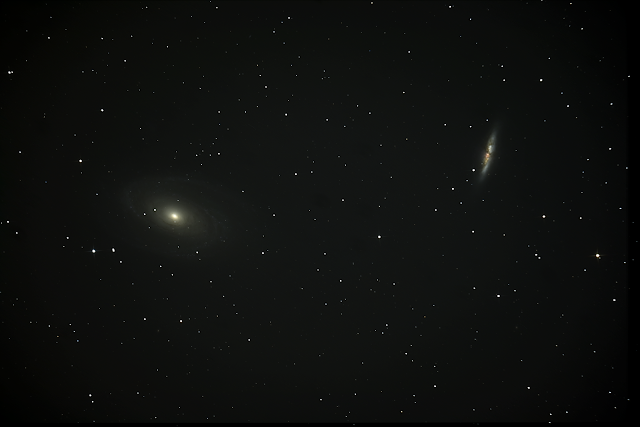Went back to M81 and M82 for longer exposures
Last night, late on the wind eventually died off and sky was clear.
I headed outside and set up everything in the garden. I am slowly getting quicker at this, it is just a shame it is all so heavy!
I had removed and cleaned the primary mirror, so did a quick collimation, which was just as well as they were quite a bit out.
Did the mount align to north, checked the spirit level was ok, a quick balance check to position the counterweights and then opened up the various software. Performing the star alignment and polar alignment is so much better than with the old mount.
Once all that was done, I started to pick out a few targets to look at, but eventually settled on a revisit of M81 and M82, but this time was going to get them centred correctly in the frame.
Set up PHD2 to commence the guiding, left it to do its calibration and once it had started guiding proceeded to take some various length of exposures to see what sort of images I was getting. Eventually settled on a 3 minute exposure, this is the longest I have been able to achieve so far.
Adjusted the imaging plan, but unfortunately I didn't notice that the plan was set to JPG files only, so never grabbed the RAWs. Must remember to check next time! 60 images of 3 minutes each grabbed.
By the time that was done, it was around 01:30 am, the sky was crystal clear and black, but there was a bit of a breeze picking up, wanted to do another run as there was still battery left, but didn't want to risk it in the wind. I just pulled everything down and back inside.
The next morning, I did the calibration frames. Again, I messed up here, as some of them were the wrong exposure lengths, 120 seconds instead of 300 seconds. I need to setup some proper plans for the future. Maybe also start to build a dark library to save me the effort repeatedly.
I coped all the images over to my main desktop PC, and when I was organising all the images, this is when I noticed the lights were only JPGs and not RAWs. D'Oh.
Checking through the subs, I noticed there were a few poor ones towards the end, so think this was the breeze picking up.
In total for the stacking I had:
54 x 300s Lights
30 x 120s Darks
30 x 1/60s Flats (using the white T-Shirt method)
50x 1/4000s Bias
They were all ISO 800 and exposure bias +5 steps.
I stacked using both DeepSkyStacker and SharpCap to see what came out. and then did some post levels clean up in GIMP. Basic curves, levels, brightness, nothing fancy, as I still haven't a clue or the patience for the post processing!
So here it is: M81 Bode's Galaxy on the left, M82 Cigar Galaxy on the right.
Having used the longer exposures this time, I can clearly see more detail starting to come out in the spirals of M81. And with this new Celestron CGX mount, I was able to position the framing exactly where I wanted it. In fact, when I selected the spot on the sky map between the two galaxy, and slewed to the target, I didn't need to move it any more, it was perfect.
M81 Bode's Galaxy
This is located around 12,000,000 light years from Earth and has a diameter of around 90,000 light years. It is estimated to contain around 250 Billion stars.
Read more on wiki at: https://en.wikipedia.org/wiki/Messier_81
M82 Cigar Galaxy
It is also located around 12,000,000 lights from earth and is heavily influenced by M81 It has a diameter of around 30,000 light years. It is estimated to contain around 30 Billion stars.
Read more on wiki at: https://en.wikipedia.org/wiki/Messier_82
Autoguiding
Here is a grab of the autoguiding stats at the end of the session. The top left of the image is the feed from the guiding camera, showing the selected star. The top right is a close up of that star and the profile of the star. Below this is the target of the star and all the points it has been during the guiding.
At the bottom of the screen there are the plot graphs, that show the Right Ascension and Declination profiles. I still have some further tuning on this to do, as reading/watching the guides for PDH suggest that a) the star profile is over-saturated and b) the aggressiveness of the guiding has room for improvement.
The general view is that if the RMS (root mean squared) total error is < 1px, then guding is good, I was 0.96, but they estimate it would be considered excellent to around 0.3-0.4
At the bottom of the screen there are the plot graphs, that show the Right Ascension and Declination profiles. I still have some further tuning on this to do, as reading/watching the guides for PDH suggest that a) the star profile is over-saturated and b) the aggressiveness of the guiding has room for improvement.
The general view is that if the RMS (root mean squared) total error is < 1px, then guding is good, I was 0.96, but they estimate it would be considered excellent to around 0.3-0.4



Comments
Post a Comment